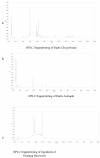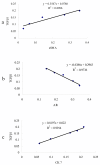Ingredients of Huangqi decoction slow biliary fibrosis progression by inhibiting the activation of the transforming growth factor-beta signaling pathway
- PMID: 22471627
- PMCID: PMC3419610
- DOI: 10.1186/1472-6882-12-33
Ingredients of Huangqi decoction slow biliary fibrosis progression by inhibiting the activation of the transforming growth factor-beta signaling pathway
Abstract
Background: Huangqi decoction was first described in Prescriptions of the Bureau of Taiping People's Welfare Pharmacy in Song Dynasty (AD 1078), and it is an effective recipe that is usually used to treat consumptive disease, anorexia, and chronic liver diseases. Transforming growth factor beta 1 (TGFβ1) plays a key role in the progression of liver fibrosis, and Huangqi decoction and its ingredients (IHQD) markedly ameliorated hepatic fibrotic lesions induced by ligation of the common bile duct (BDL). However, the mechanism of IHQD on hepatic fibrotic lesions is not yet clear. The purpose of the present study is to elucidate the roles of TGFβ1 activation, Smad-signaling pathway, and extracellular signal-regulated kinase (ERK) in the pathogenesis of biliary fibrosis progression and the antifibrotic mechanism of IHQD.
Methods: A liver fibrosis model was induced by ligation of the common bile duct (BDL) in rats. Sham-operation was performed in control rats. The BDL rats were randomly divided into two groups: the BDL group and the IHQD group. IHQD was administrated intragastrically for 4 weeks. At the end of the fifth week after BDL, animals were sacrificed for sampling of blood serum and liver tissue. The effect of IHQD on the TGFβ1 signaling pathway was evaluated by western blotting and laser confocal microscopy.
Results: Decreased content of hepatic hydroxyproline and improved liver function and histopathology were observed in IHQD rats. Hepatocytes, cholangiocytes, and myofibroblasts in the cholestatic liver injury released TGFβ1, and activated TGFβ1 receptors can accelerate liver fibrosis. IHQD markedly inhibited the protein expression of TGFβ1, TGFβ1 receptors, Smad3, and p-ERK1/2 expression with no change of Smad7 expression.
Conclusion: IHQD exert significant therapeutic effects on BDL-induced fibrosis in rats through inhibition of the activation of TGFβ1-Smad3 and TGFβ1-ERK1/2 signaling pathways.
Figures





Similar articles
-
Synergistic anti-liver fibrosis actions of total astragalus saponins and glycyrrhizic acid via TGF-β1/Smads signaling pathway modulation.J Ethnopharmacol. 2016 Aug 22;190:83-90. doi: 10.1016/j.jep.2016.06.011. Epub 2016 Jun 6. J Ethnopharmacol. 2016. PMID: 27282665
-
Astragaloside prevents BDL-induced liver fibrosis through inhibition of notch signaling activation.J Ethnopharmacol. 2015 Jul 1;169:200-9. doi: 10.1016/j.jep.2015.04.015. Epub 2015 Apr 24. J Ethnopharmacol. 2015. PMID: 25917841
-
[Huangqi decoction inhibits cholangiocyte proliferation and transdifferentiation in cholestatic liver fibrosis induced by BDL in rats].Zhonghua Gan Zang Bing Za Zhi. 2010 Jan;18(1):13-8. doi: 10.3760/cma.j.issn.1007-3418.2010.01.004. Zhonghua Gan Zang Bing Za Zhi. 2010. PMID: 20128962 Chinese.
-
TGF‑β1: Gentlemanly orchestrator in idiopathic pulmonary fibrosis (Review).Int J Mol Med. 2021 Jul;48(1):132. doi: 10.3892/ijmm.2021.4965. Epub 2021 May 20. Int J Mol Med. 2021. PMID: 34013369 Free PMC article. Review.
-
The Role of Mesothelin in Activation of Portal Fibroblasts in Cholestatic Liver Injury.Biology (Basel). 2022 Oct 28;11(11):1589. doi: 10.3390/biology11111589. Biology (Basel). 2022. PMID: 36358290 Free PMC article. Review.
Cited by
-
Yin-Chen-Hao-Tang alleviates biliary obstructive cirrhosis in rats by inhibiting biliary epithelial cell proliferation and activation.Pharmacogn Mag. 2015 Apr-Jun;11(42):417-25. doi: 10.4103/0973-1296.153098. Pharmacogn Mag. 2015. PMID: 25829784 Free PMC article.
-
Actions of Huangqi decoction against rat liver fibrosis: a gene expression profiling analysis.Chin Med. 2015 Dec 18;10:39. doi: 10.1186/s13020-015-0066-5. eCollection 2015. Chin Med. 2015. PMID: 26691002 Free PMC article.
-
Astragalus membranaceus inhibits peritoneal fibrosis via monocyte chemoattractant protein (MCP)-1 and the transforming growth factor-β1 (TGF-β1) pathway in rats submitted to peritoneal dialysis.Int J Mol Sci. 2014 Jul 22;15(7):12959-71. doi: 10.3390/ijms150712959. Int J Mol Sci. 2014. PMID: 25054320 Free PMC article.
-
Granulocyte-macrophage colony-stimulating factor (GM-CSF) shows therapeutic effect on dimethylnitrosamine (DMN)-induced liver fibrosis in rats.PLoS One. 2022 Sep 2;17(9):e0274126. doi: 10.1371/journal.pone.0274126. eCollection 2022. PLoS One. 2022. PMID: 36054162 Free PMC article.
-
Insights into the molecular mechanisms of Huangqi decoction on liver fibrosis via computational systems pharmacology approaches.Chin Med. 2021 Jul 23;16(1):59. doi: 10.1186/s13020-021-00473-8. Chin Med. 2021. PMID: 34301291 Free PMC article.
References
-
- Du JX, Qiu BF, Liu P. et al.Huangqi decoction inhibits cholangiocyte proliferation and transdifferentiation in cholestatic liver fibrosis induced by BDL in rats. Zhonghua Gan Zang Bing Za Zhi. 2010;18:13–18. - PubMed
-
- Erwin P, Bottinger MB. TGF-beta signaling in renal disease. J Am Soc Nephrol. 2002;13:2600–2610. doi: 10.1097/01.ASN.0000033611.79556.AE. - DOI - PubMed
Publication types
MeSH terms
Substances
LinkOut - more resources
Full Text Sources
Medical
Miscellaneous

